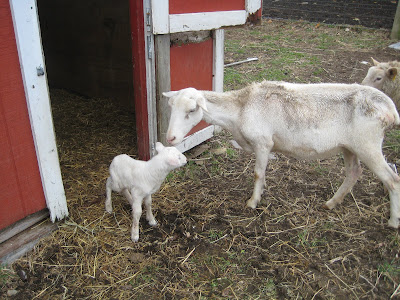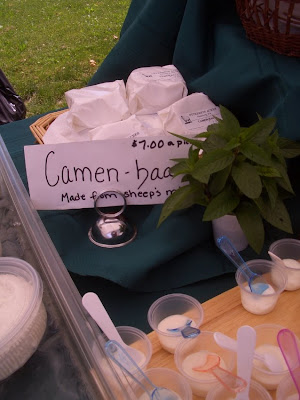“No lamb—I hate sheep. I love to eat lamb and mutton, but I will not keep them on my farm. They’re stupid and greasy.” By greasy, I mean the lanolin that coats their wool and emits that sheepy stench when you handle them. No thank you.
Furthering the irony of my dislike was when I ended up on the cover of the American Sheep Institute’s newsletter last spring when I visited the
I love cheeses, ice cream and yogurt made from sheep milk. My Amish friends, the Fishers, milk a flock of sheep not far from my farm. During their milking season, I’ll occasionally head over there right about evening milking time just to watch their very talented Border Collies bring in the ewes from the lush green pastures to the barn were they are milked on a most ingenuous carousel designed and built by John Fisher. The sheep funnel on to the rotating platform where they instinctively lock their heads into a self-catching mechanism to get a brief nibble of grain during their milking. John’s daughters, in their matching black aprons over jewel-tone solid colored dresses, organdie muslin kapps and bare feet massage each ewe’s udder to stimulate milk production prior to attaching the vacuum claws. By the time the carousel has made a revolution, the vacuum claws are detached, a dangling ring pulled releasing the head gate and the ewe ushered down a ramp to a holding pen in the barn stocked with sweet hay.
The Fishers make phenomenal cheeses from sheep and cow milk. I’ve always joked with John about adding goats to his operation to complete the dairy trifecta, but we have a firm agreement between the two of us—he dislikes goats as much as I dislike sheep.
My introduction to caring for sheep came when a friend’s daughter fell suddenly ill and was in critical care for several days. That night, I walked into her barn to find a flock of Cheviots, their whitish bodies with solid lumps of black bulging out of their heads like a tacky alien refrigerator magnet from Area 51.
“Bbbbaaaaaa,” they bellowed at me several octaves lower than that of my beloved goats’ bleating. It just didn’t sound right.
Equally disturbing was the camelids’ fearful humming of a new person in their space without the security of their own shepherdess. I’ve never seen the real appeal of llamas and alpacas having not tasted either of them to date. Maybe it also has something to do with my lack of patience and talent for the fiber arts. I can knit a scarf and that’s about it. Several expensive skeins of yarn are still in my grandmother’s knitting basket waiting for me to gain the patience and ability to knit a pair of socks.
The only species of the Camelidae family I’d ever consider would be a dromedary as I could ride it, milk it and eat it. When it comes to survival in harsh environments, camels are even tougher than goats. I wonder how camels would do in Newburg?
Back to those pasture maggots.
“Hello Sandra, I know you only have goats, but I need some mutton for my son’s aqeeqa. No, I don’t want lamb. My mother-in-law wants meat with some taste. Thanks, I look forward to hearing from you soon.”
I really enjoy dealing with my Muslim customers. They are always gracious and appreciative so when one called with this special request, I agreed to rustle him up some sheep for his firstborn’s naming ceremony.
It was early November and an inopportune time to be culling ewes as everyone’s herds were bred. Slaughtering a possibly pregnant animal is frowned upon and slicing into something with a near-term fetus can be gruesome.
“John, I need a cull ewe for some mutton. You got anything to sell?”
“Sorry, I already culled and what’s left should all be bred.”
On to the next local sheep farmer.
“Daniel, you have any ewes to cull? I need mutton for a Pakistani customer.”
“As a matter of fact, I do. I was going to get rid of her here soon before winter. When do you need her?” Daniel’s farm is between mine and the Fishers. We all sold at the same farmers market, too, and have always gone to each other for various livestock items the other may not have had. It’s a good community.
A few days later, Daniel and his son show up with what can only be described as the ugliest sheep I have ever seen. She was a Katahdin, which is a hair sheep that naturally sheds instead of needing to be shorn, but she was in such poor condition that her winter coat never filled in. Refugees from Darfur had more meat on their bones than this sorry sheep.
“Sandra, thanks for finding some mutton. I just wanted to call to let you know the caterer figures he’ll need at least a sixty-pound carcass.”
I was sunk. There was no way this ewe would even dress out at forty. A quick call to my third sheep farmers procured a larger beast to be sacrificed for the party. But what to do with the skinny ewe?
A friend from the city had been asking about learning to slaughter and dress an animal. A quick text confirmed their interest in a batch of Merguez, a spicy north African sausage, but it would have to wait until after my busy season—Eid and Thanksgiving, which fell within the same week again. I hope she lived that long.
“Sandra, my mother-in-law wants more mutton. Can we take that skinny ewe when we come for Eid next week?”
Knowing there’s always something around to make sausage out of, the skinny ewe was promised to its original customer.
It was a busy week with the Eid ul-Adha, the festival of sacrifice which signifies Abraham’s willingness to sacrifice his son. As a livestock producer, I can’t begin to convey how special it is to watch as people pray over my animals before humanely dispatching them.
All week long, Eid customers came to the farm to pick up their goats. Friday was to be the day the sheep went, along with the last of the lambs I had brought in upon request and the last of buck goats. Wednesday was still a market day and I headed out to the barn for a quick check before heading into Carlisle.
I heard it before I saw it. There was a foreign sound emanating from the red shed in the barnyard. At first, I was confused because there were only Eid animals in that pen, which meant intact males…and then I saw it. A huge lamb appeared in the doorway of the shed. Where on earth had she been hiding that thing?
The soccer ball sized udder with two large pink teats poking out the sides on the ugly ewe confirmed the source. They were ushered into the barn and off to market I went, but not before snapping a few pictures to show Daniel.
After setting up my stand, I walked over to Daniel.
“You’ve done something that people have been trying to get me to do for years. Today, you turned me into a sheep farmer.” His eyes grew large before bursting into laughter.
The ram lamb has thrived and is now nearly as big as his mother in height. By Easter, he’ll be perfect. And the ewe? She escaped death on four different occasions so I named her “Lucky”, but chances are good that after the lamb is weaned, she’ll still be sausage….maybe.


Sandy you need to keep these blogs and get them published as a book of essays.
ReplyDeletedid you ever read any of Noel Perrins books?
First Person Rural, Second Person Rural ect...
Your writing is as good and as witty as his.
Good Luck
I agree with Brent! I told Sandy that years ago, her animals all have a story to be told. Remember the Yak? What was his name? I thought he had some fine wisdom to impart to all. I love that you got some sweet sheep to come to the Painted Hand Farm and provide the other piece of the circle that is ever revolving on your special place of Earth in Newburg. LMAO! The camel and buggy special pic is awesome! You go girl!
ReplyDelete